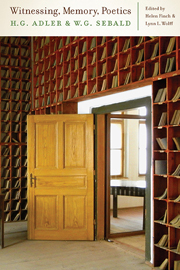Book contents
- Frontmatter
- Contents
- Acknowledgments
- List of Abbreviations
- Introduction: The Adler-Sebald Intertextual Relationship as Paradigm for Intergenerational Literary Testimony
- Part I Intertexts in Context
- 1 Opening Address: The Connections between H. G. Adler and W. G. Sebald, from a Personal Perspective
- 2 Memory's Witness—Witnessing Memory
- 3 Writing the Medusa: A Documentation of H. G. Adler and Theresienstadt in W. G. Sebald's Library
- Part II Witnessing Trauma and the Poetics of Witnessing
- Part III Memory, Memorialization and the Re-Presentation of History
- Part IV Literary Legacies and Networks
- Afterword
- Bibliography
- Notes on the Contributors
- Index
3 - Writing the Medusa: A Documentation of H. G. Adler and Theresienstadt in W. G. Sebald's Library
from Part I - Intertexts in Context
Published online by Cambridge University Press: 05 October 2014
- Frontmatter
- Contents
- Acknowledgments
- List of Abbreviations
- Introduction: The Adler-Sebald Intertextual Relationship as Paradigm for Intergenerational Literary Testimony
- Part I Intertexts in Context
- 1 Opening Address: The Connections between H. G. Adler and W. G. Sebald, from a Personal Perspective
- 2 Memory's Witness—Witnessing Memory
- 3 Writing the Medusa: A Documentation of H. G. Adler and Theresienstadt in W. G. Sebald's Library
- Part II Witnessing Trauma and the Poetics of Witnessing
- Part III Memory, Memorialization and the Re-Presentation of History
- Part IV Literary Legacies and Networks
- Afterword
- Bibliography
- Notes on the Contributors
- Index
Summary
Introduction
In the “Guardian Profile” which appeared in September 2001 in anticipation of the UK launch of Anthea Bell's translation of W. G. Sebald's Austerlitz (2001), interviewer Maya Jaggi describes how Sebald “loathes the term ‘Holocaust literature.’” While the assertion no doubt owes something to Adorno's famous dictum, Sebald is quoted as stating, “It's a dreadful idea that you can have a sub-genre and make a speciality out of it; it's grotesque.” Attempts at “recreations” are described as “an obscenity”—according to Jaggi, Sebald commends Lanzmann's Shoah but condemns Schindler's List—and he asserts: “I don't think you can focus on the horror of the Holocaust. It's like the head of the Medusa: you carry it with you in a sack, but if you looked at it you'd be petrified.” Turning to his own practice (referring to Die Ausgewanderten (1992; The Emigrants, 1996), but also by implication to the recently published Austerlitz), Sebald claims that “I was trying to write the lives of some people who'd survived—the ‘lucky ones.’ If they were so fraught, you can extrapolate. But I didn't see it; I only know things indirectly.”
- Type
- Chapter
- Information
- Witnessing, Memory, PoeticsH. G. Adler and W. G. Sebald, pp. 55 - 78Publisher: Boydell & BrewerPrint publication year: 2014



